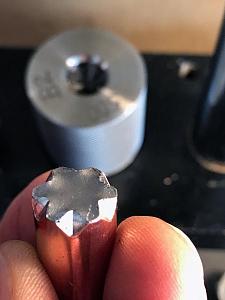Some might remember a thread I posted last year about drawing jackets from Strip. I have been using and enjoying that tooling set for the past year, and thought I would post a thread which shows how some of those heavy jackets can be used. The thread below is sort of a "how to" thread which shows some of Corbin's tooling in use. Many probably look at his website and the stuff he sells there, but it always left me wanting as there is very little of it shown in action. In this thread you will see some of that.
The object is to make 500 grain and up .50 caliber bullets. These are actually .500, not .510. They are for use in the new Bighorn Armory.50 caliber autolader which you can see here
The first step is to make the core and trim the jacket. The core is 292 grains made from .365 wire I extruded and swaged to yield .370 cores. The jacket was trimmed in a pinch trim die. The preswaged assembly can be seen here:
I wanted to put a boat tail on these bullets for a bunch of reasons, but mainly because for heavy bullets they are more accurate. Here you can see the core and jacket loaded into the BT1 die ready to get swaged:
Since these jackets are .065" thick, it takes 1600# of dial pressure to get the jacket to expand and seat the core. It actually takes three hits from the press to get the kind of definition you need. Further, since so much pressure is required, you need to use an external punch which prevents the lead from squirting past the punch or rupturing the jacket. This takes a lot of trial and error to get the right core and jacket length combination. The result can be seen here after being processed through the BT1 preform die:
The bottom of the swaged bullet:
And the top:
Next is to finish the boat tail using the BT2 boat tail finish die. It puts a sharp ring on the boat tail which is similar to, but superior to ordinary boat tail designs. According to Corbin, the sharp ring diverts the gases at right angles upon exiting the bore and it makes the bullet more accurate. The tooling that does this is shown here:
As before, it took multiple hits inside the BT2 die at 1600# or dial pressure to get the boat tail finished. It's not as sharp as a thinner jacket would yield, but good enough to get the desired effect:
Next, to help the jacket open up upon impact, I used the "saber tooth punch" which you use in the BT2 finish die. The only difference is you put the bullet in upside down and press the bullet nose first into the die which is opposite it's normal function. The external punch has a mirror image of the boat tail machined into it to press it into the die. Punch shown here:
The result at 500# of dial pressure. Starting to look like a real bullet:


|
   
   
|


|






 Reply With Quote
Reply With Quote









